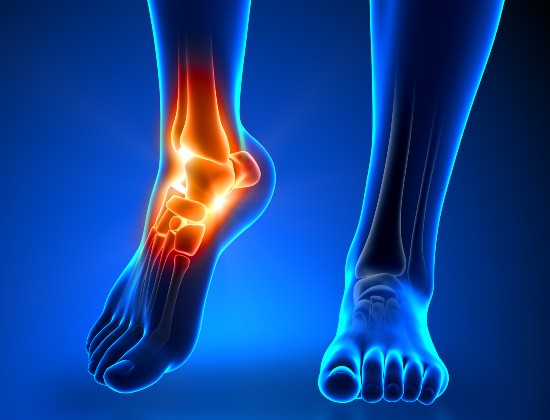Ankle sprains and instability
The ankle joint acts as a hinge between the leg and foot where the bones of the leg (the tibia and fibula) meet the top (dome) of the ankle joint (talus). These bones are held securely together by ligaments, strong bands of collagen tissue. Muscles attached to the bones of the foot add to the stability of the joint.
What causes ankle sprains?
Ankle sprains are usually caused by the foot being twisted suddenly, often with the sole pointing inwards, which called an ‘inversion injury’.
- The deltoid ligament is on the inside of the ankle and can sometimes be torn during severe ankle fractures
- The outside of the ankle has three ligaments. The front band (also called the anterior talo-fibular ligament) is most commonly injured, along with ligaments that hold the tibia and fibula together which may also be injured during severe sprains or fractures
What are the symptoms?
- When the ligament fibres are stretched, this causes pain, swelling and bruising. In most cases, it’s still possible to put some weight on the foot after an ankle sprain, but it may mean you walk with a limp
- More serious sprains can cause the ligament to be ruptured (torn), or a small piece of bone can come loose from where the ligament is attached and this may make it very painful (or impossible) to put weight on the foot. It may also cause ankle instability
- In some cases, bones around the ankle may be broken or dislocated, or the smooth surface of the ankle bone (talus) and tendons around the ankle joint may be damaged causing osteochondral injury of the ankle
Ankle instability
This is when the ankle continues to feel unstable after a fracture or sprain and 'gives way’ (which can cause more injuries).
How is it diagnosed?
If you are able to put weight on your ankle, and the swelling recovers within a few days, it’s likely to be a simple sprain that should start to recover in a few days. However, if you are unable to put weight on your ankle, you should seek advice from your GP or local Accident & Emergency department. You may be offered an X-ray to check for more serious damage.
How is it treated?
- In most cases, less serious sprains will recover within a few days with the help of rest, ice, compression and elevation (lifting your foot above the level of your heart)
- With physiotherapy, including ankle sprain exercises, most people (even those with more serious sprains) are able to recover normal movement without the need for surgery. Physiotherapy also improves coordination of the muscles (or proprioception) following damage to nerve endings during a severe sprain
- If the ankle does not return to normal within a few months, or is still painful six months after an injury, this may need further investigation/treatment using ankle arthroscopy and you may be offered ankle ligament reconstruction surgery to repair the damage
Important: This information is only a guideline to help you understand your treatment and what to expect. Everyone is different and your rehabilitation may be quicker or slower than other people’s. Please contact us for advice if you’re worried about any aspect of your health or recovery.


